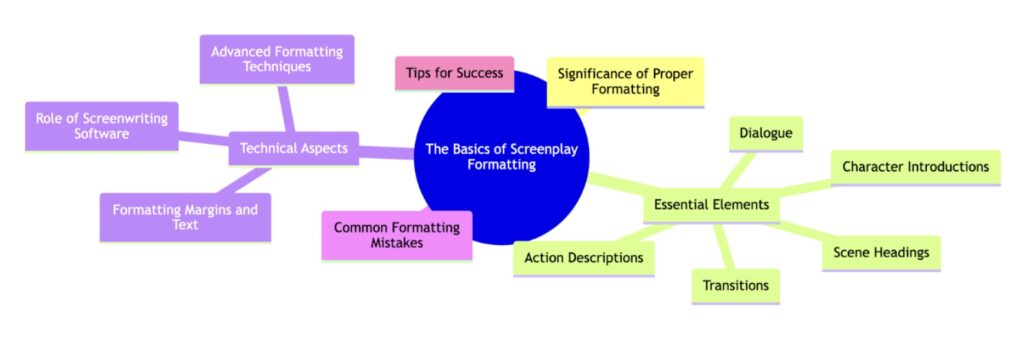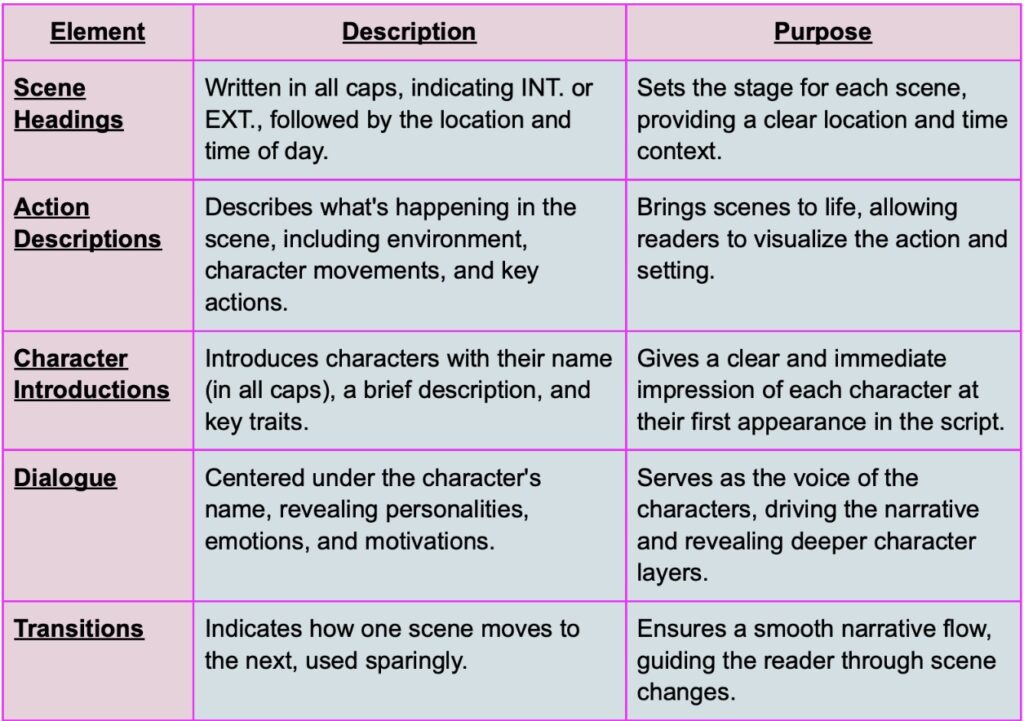In the world of screenwriting, the power of a well-formatted screenplay is often understated. It’s not just about following rules but crafting a script that speaks volumes through its structure and clarity. This article is a deep dive into the art of screenplay formatting, highlighting its critical elements and offering insights to elevate your script from good to great. Whether you’re a budding screenwriter or a seasoned professional, understanding the nuances of screenplay formatting is critical to making your script stand out in the competitive realm of film and television.
Key Takeaways:
- Screenplay formatting is crucial for readability and professional acceptance.
- Key elements include scene headings, action descriptions, character introductions, dialogue, and transitions.
- Adherence to industry standards in formatting is essential for a script’s success.

The Significance of Proper Screenplay Formatting
The proper screenplay format does more than just make your script look professional; it transforms your written words into a visual blueprint for filmmakers. A well-formatted screenplay is a tool that helps readers visualize your story, guiding them through the narrative with ease and clarity. In this section, we explore the importance of formatting and its impact on your script’s reception in the film industry.
Why Format Matters
A properly formatted script clearly indicates a writer’s professionalism and understanding of the industry. It ensures that your screenplay is not only easy to read but also adheres to the standards that industry professionals expect. This adherence is not just about following rules; it’s about demonstrating your commitment to your craft and respect for the reader’s time and experience.
Impact on Screen Time
The standard screenplay format has a direct correlation with screen time. Typically, one page of a properly formatted script translates to approximately one minute of screen time. This ratio is crucial for producers and directors as it helps them estimate the length and budget of the film. A well-formatted script makes this estimation process smoother, increasing your chances of taking your script seriously.
Essential Elements of Screenplay Formatting
Understanding and mastering the essential elements of screenplay formatting is crucial for any screenwriter. Each component of the script format serves a specific purpose, contributing to the overall flow and readability of the story.
1. Scene Headings: Setting the Stage
Scene headings, or slug lines, are critical in setting up the location and time of each scene in your screenplay. They are typically written in all caps and include whether the scene is interior (INT.) or exterior (EXT.), followed by the location and time of day. This clear, concise information is vital for readers to visualize your scene’s setting instantly.
2. Action Descriptions: Bringing Scenes to Life
In action descriptions, you paint a picture of what’s happening in the scene. This is your opportunity to bring your story to life, describing the environment, character movements, and key actions. The key to compelling action descriptions is clarity and brevity; you want to provide enough detail to set the scene without overloading the reader with unnecessary information.
3. Character Introductions: Making a Strong First Impression
The first time a character appears in your screenplay, their introduction is crucial. This includes their name (in all caps), a brief description, and any crucial characteristics relevant to the story. A well-crafted character introduction gives readers a clear image of who the character is and their role in the story.
4. Dialogue: The Voice of Your Characters
Dialogue is the heart of your characters, revealing their personalities, emotions, and motivations. When formatting dialogue, it should be centered and placed under the character’s name. Good dialogue is not just about what is said; it’s about how it’s said, often revealing more than the words themselves.
5. Transitions: Guiding the Reader Through the Story
Transitions in a screenplay indicate how one scene moves to the next. They are used sparingly and only when necessary to denote changes in time or location, or to highlight a specific narrative element. Effective use of transitions ensures a smooth flow of your story, guiding the reader seamlessly from one scene to the next.
Table 1: Key Elements to Include in a Screenplay

Technical Aspects of Screenplay Formatting
In addition to the narrative elements of a screenplay, the technical aspects of formatting play a crucial role in ensuring your script meets industry standards. This section covers the specifics of formatting margins, text, and the advantages of using screenwriting software.
Formatting Margins and Text
The physical layout of your script is just as important as its content. Proper margins and text formatting ensure that your screenplay is easy to read and adheres to the industry’s standard page-to-minute ratio.
- Top Margin: Approximately 1 inch.
- Bottom Margin: Roughly 1 inch.
- Left Margin: About 1.5 inches.
- Right Margin: Generally 1 inch.
The text of a screenplay is traditionally formatted in 12-point Courier font. This monospaced font is preferred because it creates a uniform page layout, making it easier to estimate the length of a scene or the entire script. (1)
The Role of Screenwriting Software
Using specialized screenwriting software can significantly streamline the formatting process. These tools are designed to automatically format your script to industry standards, allowing you to focus on the creative aspects of writing.
- Final Draft: Widely regarded as the industry standard, offering robust formatting features and a user-friendly interface.
- Celtx: A popular choice for beginners, known for its ease of use and collaborative features.
Advanced Formatting Techniques
Once you’ve mastered the basics, incorporating advanced formatting techniques can add a professional polish to your script.
Dual Dialogue
When two characters speak simultaneously, dual dialogue formatting is used. This technique involves placing the characters’ dialogue side by side, allowing for a dynamic representation of simultaneous conversation.
Montages and Series of Shots
Montages or a series of shots are formatted with each shot or scene described in a new line, often preceded by the term “MONTAGE” or “SERIES OF SHOTS.” This format conveys a sequence of actions or images that collectively tell a part of the story.
Navigating Common Screenplay Formatting Mistakes and Tips for Success
Crafting a screenplay that resonates with readers requires a compelling story and a keen eye for formatting details. This final section highlights common mistakes to avoid and provides practical tips to ensure your screenplay stands out for all the right reasons.
Common Formatting Mistakes to Avoid
Even experienced screenwriters can fall prey to certain formatting pitfalls. Being aware of these common errors can help you maintain a professional standard:
- Inconsistent Scene Headings: Ensure uniformity in your slug lines. Mixing formats can confuse readers and disrupt the flow of your script.
- Overly Descriptive Action Lines: While setting the scene is essential, too much detail can bog down the narrative. Keep action descriptions concise and relevant.
- Misplaced Dialogue: Dialogue should always be correctly aligned and follow the character’s name. Misalignments can disrupt the reading experience.
- Ignoring White Space: A script crammed with text can be overwhelming. Use white space effectively to enhance readability and pacing.
- Incorrect Use of Parentheticals: Overusing parentheticals can clutter your script. Use them sparingly to convey essential information about dialogue delivery.
Tips for Maintaining a Professional Screenplay Format
To ensure your screenplay not only reads well but also meets industry expectations, consider these tips:
- Stay Updated on Formatting Trends: While the basics of screenplay formatting remain constant, staying abreast of current trends and preferences in the industry can give your script an edge.
- Read Professional Screenplays: One of the best ways to understand formatting nuances is to read scripts from successful films and TV shows. This practice can provide insights into effective formatting techniques.
- Proofread and Edit: A screenplay free of typos and formatting errors reflects your professionalism and attention to detail. Regular proofreading and editing are essential.
- Seek Feedback: Getting feedback from peers or professionals can provide a fresh perspective on your script’s format and content.
- Practice Consistency: Consistency in formatting is key. Maintaining a uniform style throughout your script is crucial, whether it’s scene headings, dialogue, or action descriptions.
By avoiding common mistakes and adhering to these tips, you can ensure that your screenplay not only tells a compelling story but also presents it in a format that engages and impresses industry professionals.
Wrapping Up
Mastering the basics of screenplay formatting is an essential skill for any screenwriter. From the initial scene heading to the final fade out, every element of your script’s format plays a vital role in bringing your story to life. By adhering to industry standards and infusing your script with clarity and precision, you set the stage for your screenplay to captivate the minds and hearts of your audience.

